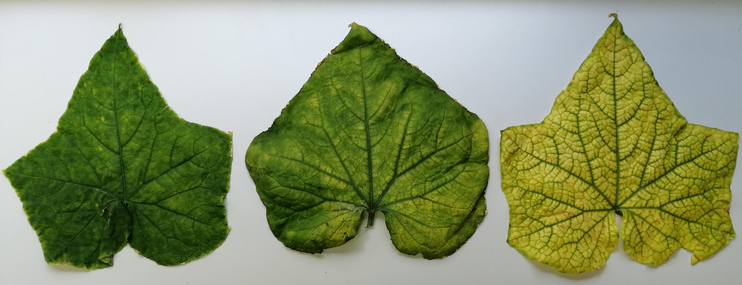Plant virologist Dr. Wulf Menzel of the Leibniz-Institute DSMZ – German Collection of Microorganisms and Cell Cultures in Braunschweig, Germany, and his colleagues from Nuremberg and Freising identified the “cucumber virus” Cucurbit aphid-borne yellows virus (CABYV) in Germany for the first time. The scientists recently published their findings in the renowned journal New Disease Report. In the summer of 2019, a large number of Bavarian farmers reported an infection of their cucumbers plants with an unknown disease. In most holdings, the infection rate was 10-50 percent. In some cases up to 90 percent of plants were affected, the crop yield dropped by up to 50 percent. Serologic and molecular tests effectively verified an infection with CABYV.
Cucumber virus: Cucurbit aphid-borne yellows virus
The cucurbit aphid-borne yellows virus was discovered in 1988 in France; it infects cucurbits such as cucumber, courgette, melon or pumpkin. An infection leads to a lack of chlorophyll and leaf thickening and is associated with a potentially massive loss of harvest yields. The virus is transmitted by aphids and commonly found across the Mediterranean region.
Establishment of virus also expected in central Europe
The researchers assume that CABYV will also establish itself outside Mediterranean countries. “In addition, the virus has been spotted in Czech Republic, Slovakia and Poland”, states Dr. Wulf Menzel of the DSMZ. “As both the aphids that transmit the virus and the natural overwintering hosts such as various weeds are native to our country, it is possible to assume that the virus will threaten cucurbits in Germany and in other central European countries as well by next year.” For growers of cucumber and the like in greenhouse cultivation, the plant virologist therefore recommends taking effective preventive measures, such as preventing aphid infestations.
Original publication
Menzel W, Maeritz U, Seigner L, 2020. First report of Cucurbit aphid-borne yellows virus infecting cucurbits in Germany. New Disease Reports 41, 1. http://dx.doi.org/10.5197/j.2044-0588.2020.041.001
Press contact:
Sven-David Müller, Head of Public Relations, Leibniz Institute DSMZ-German Collection of Microorganisms and Cell Cultures GmbH
Phone: ++49 (0)531/2616-300
Mail: Sven.David.Mueller@dsmz.de
About the Leibniz Institute DSMZ
The Leibniz Institute DSMZ-German Collection of Microorganisms and Cell Cultures is the world's most diverse collection of biological resources (bacteria, archaea, protists, yeasts, fun-gi, bacteriophages, plant viruses, genomic bacterial DNA as well as human and animal cell lines). Microorganisms and cell cultures are collected, investigated and archived at the DSMZ. As an institution of the Leibniz Association, the DSMZ with its extensive scientific services and biological resources has been a global partner for research, science and industry since 1969. The DSMZ is the first registered collection in Europe (Regulation (EU) No. 511/2014) and certified according to the quality standard ISO 9001:2015. As a patent depository, it offers the only possibility in Germany to deposit biological material in accordance with the requirements of the Budapest Treaty. In addition to scientific services, research is the second pillar of the DSMZ. The institute, located on the Science Campus Braunschweig-Süd, accommodates more than 72,500 cultures and biomaterials and has 198 employees. www.dsmz.de
The Leibniz Association
The Leibniz Association connects 95 independent research institutions that range in focus from the natural, engineering and environmental sciences via economics, spatial and social sciences to the humanities. Leibniz Institutes address issues of social, economic and ecological relevance. They conduct knowledge-driven and applied basic research, maintain scientific infrastructure and provide research-based services. The Leibniz Association identifies focus areas for knowledge transfer to policy-makers, academia, business and the public. Leibniz institutions collaborate intensively with universities – in the form of “Leibniz ScienceCampi” (thematic
partnerships between university and non-university research institutes), for example – as well as with industry and other partners at home and abroad. They are subject to an independent evaluation procedure that is unparalleled in its transparency. Due to the importance of the institutions for the country as a whole, they are funded jointly by the Federation and the Länder, employing some 19,100 individuals, including 9,900 researchers. The entire budget of all the institutes is approximately 1.9 billion Euros. www.leibniz-gemeinschaft.de


